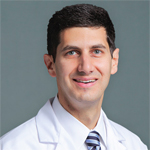Jonathan Samuels, MD, an associate professor and clinical researcher focusing on osteoarthritis of the hands and knees, has also been enrolling his patients in the SAMPLE biorepository. In addition to his practice at the NYU Langone’s Center for Musculoskeletal Care, he also spends time teaching at the Manhattan VA and Bellevue sites. Now branching off into clinical research using musculoskeletal ultrasound, and studying the impact of bariatric surgery on osteoarthritis, Dr. Samuels credits the tone set by Director Buyon and his initial recruitment by Dr. Abramson for fostering his own ongoing opportunities within the Division.

Jonathan Samuels, MD, Associate Professor, Department of Medicine
Dr. Abramson maintains an active research laboratory focused on osteoarthritis in partnership with Mukundan Attur, PhD, assistant professor of medicine. “We have the resources to do wonderful things, and a welcoming environment to make those happen,” Dr. Samuels says.
Probing Ethnic Disparities in Lupus
The Division’s reputation and opportunities to do clinical and basic science are obviously very attractive. Still, “It took a very special program to bring me here,” says Ashira Blazer, MD, instructor of medicine. Having trained in Texas and Tennessee, Dr. Blazer had been focused on lupus, mostly in a clinical setting, but the fellowship program at NYU Langone offered the opportunity to work with Drs. Buyon and Clancy to add research to her skillset. Recipient of a 2015 Rheumatology Research Foundation Scientist Development Award, Dr. Blazer has focused her research on racial and ethnic disparities in lupus and is adding to the knowledge base through her current collaboration with West African researchers to collect primary data and samples from Ghanaian patients, and to compare those with data in NYU Langone’s SAMPLE biorepository.
In the U.S., Dr. Blazer points out, “African American ethnicity is almost seen as a surrogate for socioeconomic status.” From that notion springs the belief that lower socioeconomic status is the principal driver of outcomes in African Americans with lupus. These conceptions (or misconceptions), she asserts, do not capture the true reasons behind disparate outcomes and draw attention away from potential biologic or genetic causes. “Having the opportunity to look at true biologically determined differences is a great one,” she notes. “This [working at NYU Langone] is the culmination of everything I’ve worked for.”
On the home front, Peter Izmirly, MD, assistant professor of medicine, continues NYU’s attention to minority health through his recent leadership of a major Centers for Disease Control and Prevention (CDC) project to study the epidemiology of lupus in Asians and Hispanics.
Hospital at the Core
It was Lewis Thomas who believed that “real science should be done on the same floor and by the same people who are treating patients,” says Dr. Weissmann. The co-location of research labs at Bellevue Hospital [now officially known as NYC Health + Hospitals/Bellevue] became “the center of what has made NYU Langone rheumatology spectacular,” he points out.


